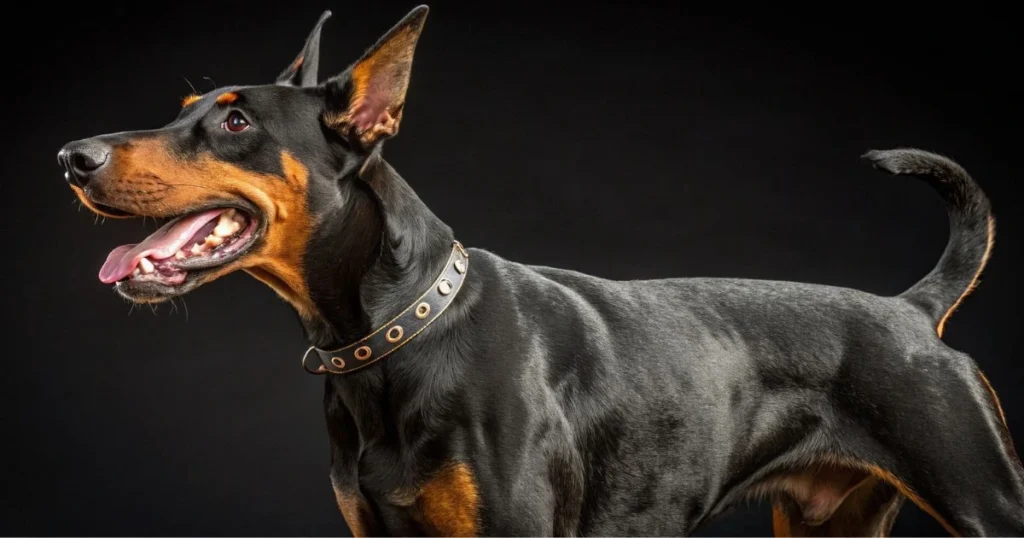Everything You Need to Know About the Doberman Lab Mix Breed
Imagine a dog that’s as protective as a Doberman and as friendly as a Labrador Retriever. Now imagine that same dog curled up next to you on the couch, eager to protect you, love you, and play fetch with you all in the same day. That’s not a fantasy — that’s the Doberman Lab Mix, affectionately known as the Doberdor.
If you’ve ever felt torn between choosing a guard dog and a family-friendly companion, this hybrid offers a powerful solution. This article will walk you through everything you need to know about the Doberman Lab Mix breed, so you can decide whether this remarkable dog fits into your life.
Table of Contents
🧬 What Is a Doberman Lab Mix?

When two iconic breeds like the Doberman Pinscher and the Labrador Retriever are crossed, the result is a blend of brains, brawn, and affection.
📜 The Doberdor’s Origins
You’re not looking at a breed with a centuries-old pedigree here. The Doberdor is part of the modern designer dog movement, developed to capture the strengths of two beloved breeds. While not recognized by major kennel clubs like the AKC, the Doberdor is rapidly gaining popularity in homes across the country.
🧬 What Traits Come from Each Parent?
- Doberman Pinscher: Known for loyalty, intelligence, and guarding ability.
- Labrador Retriever: Famous for playfulness, friendliness, and obedience.
This mix gives you a dog that can alert you to danger and still cuddle with your kids without a problem.
🐕 Physical Appearance of the Doberman Lab Mix
No two Doberdors look exactly alike, but you’ll notice common physical patterns that stem from their heritage.
📏 Size and Build
| Age Range | Weight (lbs) | Height (inches) |
|---|---|---|
| 3–6 months | 25–45 | 14–18 |
| 6–12 months | 45–65 | 18–22 |
| Adult | 60–100 | 22–28 |
Expect a powerful, athletic frame — muscular like a Doberman with the solid stance of a Lab. Their legs are usually long, their chest deep, and their gait smooth and agile.
🐾 Ears, Coat, and Color
- Ears may be floppy like a Lab’s or slightly erect like a Doberman’s.
- Coat: Short to medium in length, dense, and water-resistant.
- Common Colors: Black, chocolate, tan, and even rust or dual-tone combinations.
✂️ Grooming Requirements
You won’t spend hours grooming a Doberdor, but a few weekly practices will keep their coat healthy and your home cleaner:
- Brush 2–3 times a week to manage shedding
- Bathe monthly or after dirty outdoor play
- Trim nails regularly and brush teeth weekly
🧠 Temperament and Behavior
The Doberman Lab Mix isn’t just a pretty face. You’re looking at a dog that thinks fast, learns quickly, and loves fiercely.
👨👩👧👦 Great with Families
This hybrid loves being part of a pack — especially if that pack includes kids. You’ll find that Doberdors:
- Are naturally affectionate and gentle with children
- Can be protective but rarely aggressive when socialized early
- Thrive on routine and regular interaction
However, if you’re away from home often, you may need to consider doggy daycare or a companion pet, as they don’t do well alone for extended periods.
🎓 Trainability & Intelligence
You’re in for a treat when training this breed. Thanks to their Doberman and Labrador genes, Doberdors respond well to structured guidance.
- Use positive reinforcement: treats, praise, or playtime
- Avoid harsh discipline — it can make them anxious or rebellious
- Incorporate games and challenges to keep their minds sharp
🧑🤝🧑 Socialization Tips
Early and frequent socialization helps your Doberdor feel confident in new environments. Here’s how you can guide them:
- Introduce them to other pets and people from puppyhood
- Take them to dog parks and pet-friendly spaces
- Sign up for puppy training or agility classes
🏋️♂️ Exercise & Energy Requirements

This isn’t the type of dog that lounges all day. If you’re not an active person, you’ll need to adjust — because your Doberdor certainly won’t.
🕒 Daily Physical Activity
Aim for at least 60–90 minutes of active play or structured exercise. They love:
- Fetch and tug-of-war
- Jogging or hiking
- Obstacle or agility courses
Without regular exercise, you risk engaging in destructive behaviors such as chewing, barking, and digging.
🏠 Living Space Considerations
While some dogs can adapt to small apartments, Doberdors need space.
- Best suited for homes with yards
- Apartment living requires multiple daily walks and stimulation
- Crate training helps when you’re away, but shouldn’t be overused
🥗 Diet & Nutrition for a Doberman Lab Mix
A healthy Doberdor is a happy one — and what you feed them plays a huge role in their overall well-being.
🥣 Daily Feeding Schedule
- 2–3 meals a day
- Avoid free-feeding (leaving food out all day)
- Use puzzle feeders to slow down fast eaters
🐶 Age-Appropriate Nutrition
| Dog Size | Age Group | Recommended Food | Protein % | Notes |
|---|---|---|---|---|
| Medium-Large | Puppy | High-protein kibble | 28–30% | Bone & brain development |
| Adult | Adult | Active dog formula | 25–27% | Maintain lean muscle |
| Senior | Senior | Joint-health formula | 22–24% | Add glucosamine |
🍖 What to Avoid
- Foods high in fillers like corn or soy
- Table scraps or fatty meats
- Overfeeding — Doberdors can gain weight quickly
🏥 Health Considerations for the Doberman Lab Mix

Every dog breed has its vulnerabilities, and this mix is no exception. Understanding the common health concerns helps you stay proactive, not reactive.
💡 Common Health Risks
- Hip and elbow dysplasia (especially from the Labrador side)
- Heart disease (Dobermans are known to carry this gene)
- Obesity and joint strain
- Bloat — feed smaller meals and limit activity post-eating
🧬 Preventive Care
- Annual vet visits for early detection
- Vaccinations and flea/tick control
- Regular dental care
🕰️ Lifespan
A healthy Doberdor can expect to live for 10 to 14 years on average. You can keep yours at the upper end of that range by providing good care, exercising regularly, and eating a nutritious diet.
🏡 Is the Doberman Lab Mix the Best Dog for You?
Choosing a Dobermann entails committing to a lifestyle that is active, loyal, and mentally stimulating.
✅ Pros
- Loyal and intelligent
- Friendly with children and other pets
- Protective without being overly aggressive
- Eager to learn and work
❌ Cons
- Requires a lot of daily exercise
- May develop anxiety if left alone too long
- Not ideal for small apartments
- Needs early socialization and consistent training
If you love the idea of a dog that keeps you on your toes — mentally and physically — then the Doberdor might just be your perfect match.
❓ Frequently Asked Questions About the Doberman Lab Mix

🔹 How big will a Doberman Lab Mix get?
Most Doberdors reach 60 to 100 pounds and stand between 22 to 28 inches tall when fully grown. Males tend to be larger than females.
🔹 Is the Doberman Lab Mix aggressive?
Not inherently. They’re protective but not naturally aggressive. With early socialization and training, your Doberdor will be alert but friendly.
🔹 How much exercise should a Doberman Lab Mix get?
Plan for 60 to 90 minutes per day. Without it, they may become bored and destructive.
🔹 Does this breed shed?
Yes — moderately. Weekly brushing keeps the shedding manageable and helps maintain a healthy coat.
🔹 Is the Doberdor good with kids?
Absolutely. The breed generally does really well with kids, and is often a very happy member of a family when raised with supervision and structure.
✅ Final Thoughts: A Powerful Blend of Heart and Loyalty
You’ve now seen what makes the Doberman Lab Mix such a special hybrid — one part protector, one part goofball, and one hundred percent loyal companion. Owning a Doberdor means welcoming a dynamic personality into your life, one that’s ready to hike mountains with you during the day and curl up by your side at night.
If you’re ready for a dog who challenges you, loves you, and watches over you like family — then maybe the Doberdor is already waiting for you to bring them home.







